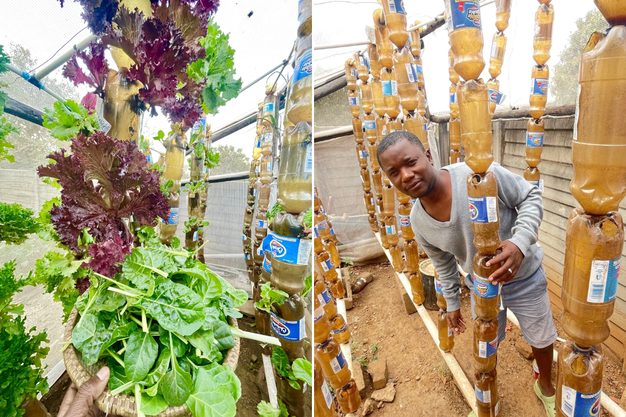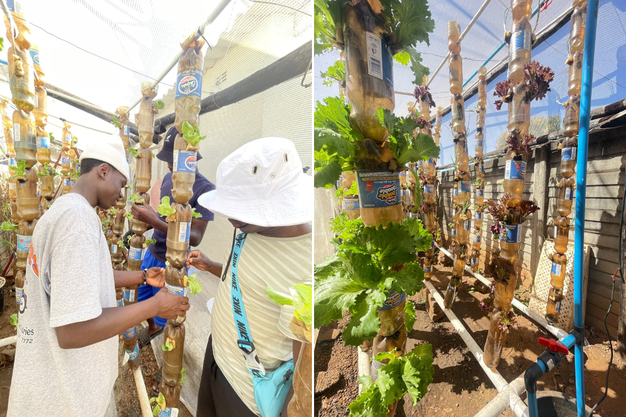“I was fascinated by high-efficiency vertical farming systems, but doing research and looking at commercial aeroponic systems, my bank account screamed in agony. My inner entrepreneur voice said, there has to be a cheaper way to grow food efficiently,” says Phathisani Vundla, founder of Zambezi Eco Sprouts in Bulawayo, Zimbabwe.
His frustration with expensive technology is set against the backdrop of a country grappling with severe challenges. UNICEF estimates that 2.7 million people in rural Zimbabwe were food insecure during the 2023/24 lean season, while FAO highlights how recurring droughts continue to threaten agriculture. At the same time, UNEP reports that cities such as Bulawayo lack the necessary infrastructure to manage the increasing amount of plastic waste.
Zambezi Eco Sprouts attempts to address these crises with a single innovation: transforming discarded bottles into vertical farming infrastructure.
 © Zambezi Eco Sprouts
© Zambezi Eco Sprouts
Repurposing waste into aeroponic towers
“When I looked at the expensive vertical towers, I wondered if I could mimic that tube-like structure. Suddenly, the discarded plastic bottles scattered around our community weren’t just trash but perfectly shaped, durable components. It felt like the universe was offering us a zero-cost farm.”
The system uses discarded two-liter PET 1 bottles, cleaned and re-engineered into vertical towers that mimic the shape of commercial aeroponic structures. Solar panels power low-energy pumps that cycle nutrient solution through the towers, misting plant roots at timed intervals, with pipes beneath the towers capturing any excess and recycling it back to the reservoir.
Closing the loop on nutrients
Instead of relying on imported fertilizers, Vundla developed a closed-loop nutrient cycle. Chickens raised by Vundla provide droppings that, combined with organic waste, are turned into vermi-compost. This is brewed into a nutrient-rich tea, then filtered through cloth and wire mesh to avoid clogging pumps. “Aeroponics is highly precise. The nutrients must be dissolved perfectly to mist the roots. I had to build a rigorous filtering process and constantly check to ensure the balance of nutrients is spot on. It’s not glamorous, but it works.”
The design allows the farm to operate completely off-grid and conserve resources. “We save up to 90% of water, which is critical in Zimbabwe where persistent droughts are part of life.”
 © Zambezi Eco Sprouts
© Zambezi Eco Sprouts
Proof of concept and overcoming challenges
The proof-of-concept phase repurposed 1,200 bottles and produced about 2,400 plants, mainly lettuce, spinach, and green onions. Crops mature in 4 to 6 weeks, enabling staggered harvests and a steady weekly supply. “Our immediate target is to repurpose 24,000 bottles,” says Vundla. “Long term, we’re committing to 100,000 bottles dedicated to growing food.”
The journey has involved setbacks. “The first design failed dismally because I was a one-man operation. The moment I started involving other people and leaving room for ideas, the project started flourishing.” Community skepticism was another challenge. “At times I started doubting myself, but the drive to inspire the community and grow my own food brought me back to the workbench.”
Looking ahead
For Vundla, each tower represents bottles taken out of the city’s waste stream and turned into a growing system, proof that vertical farming can be made affordable in places where high-tech systems are out of reach.
With trials already underway on peppers, cucumbers, strawberries, and tomatoes, he sees the next phase as an opportunity to move up the value chain. “If our upcycled, solar-powered towers can produce gourmet crops, we can shift from providing essential nutrition to capturing premium markets.”
For more information:
Zambezi Eco Sprouts
Phathisani Vundla
[email protected]
Phathisani Vundla on LinkedIn
Source: The Plantations International Agroforestry Group of Companies
